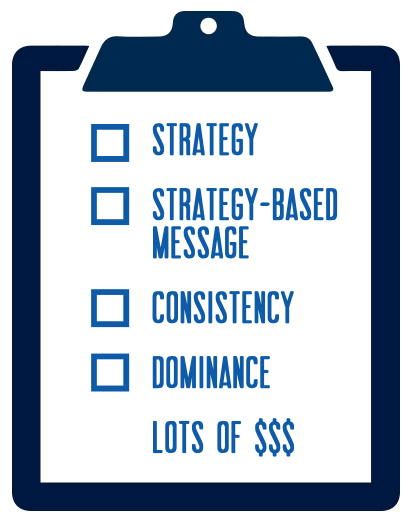One of the common objections business owners have for radio advertising is that the only way to be effective is to:
- Dump a large amount of money into it; and
- Run a saturation schedule (run ads all the time so listeners hear your name over and over again).
This is not true, and unfortunately, this line of thinking is what hinders the effectiveness of not only radio, but any media. Especially with regard to constructing and executing a well thought-out marketing campaign. We believe you need four things to be successful on radio or any advertising medium.
#1: A Strategy
This is your foundation of any marketing and advertising investment. A strategy outlines your goals and measurements for success – setting your expectations for a return on your investment. Once you have goals set, you can define how to achieve them, specifying the tactics, outlets, and tools you’ll use.
Any advertising initiative started without a defined goal is going to end up costing a lot of money – and produce low results when compared to how much money you invest. Simply running radio ads isn’t enough – there needs to be a purpose behind them.
#2: A Strategy-Based Message
After you know what you’re trying to achieve you’ll need to decide what to say. This is cited as the most challenging part for businesses. This is our sweet spot; we specifically train our account executives about the importance of a great strategy and message when it comes to radio advertising. They can help you uncover your unique selling position and craft messages that will resonate with radio listeners and encourage action.
People respond to a need, not your ad; so it all comes down to sending a strategy-based message that addresses a need and calls them to the action you’ve set out to achieve.
#3: Consistency
In advertising, sameness, repetition and continuity are important. Please note, I am not saying be boring or monotonous; not at all. What I am saying is that your audience is being inundated with advertising messages, at all times.

In order to stand out, you have to be anything but boring; and in order to be remembered, you need to be consistent. Sending the same message, across all marketing channels (not just what you do on the radio), for an extended period of time fosters recognition, relevance, trust, and remembrance.
#4: Dominance
Our definition of dominance is 21 to 30 radio ads per week, per station; each station will have their own terms depending on it's demographics, geographic reach, and average time spent listening.
Dominance, also referred to as frequency, is the second leg needed to drive your brand/message into the memory of your audience.
Your strategy will have defined which stations you should run your radio ads on, based on your target audience; dominance will guide how often your strategy-based messages will run.
Successful Advertising ≠ $$$$
Please notice that “A Large Budget” or “Boatload of Money” was not listed as an essential component to successful radio advertising. Your investment should reflect the goals you wish to achieve and your timeline for doing so.
Westwood One, a radio network that syndicates various types of programs for stations across the country, wanted to know if it's advertisers were getting a return on their investment. So, they commissioned a study and found that radio advertisers in the consumer-packaged goods (CPG) industry saw a 12 to 1 return on their radio advertising investment. Simply put, for every $1 spent they saw $12 in sales.
Because of these findings, Westwood One now offers an ROI guarantee for their advertisers. Why? Because they have proof that radio works!
The Proof is in the Pudding
Further studies by Nielson have proven time and time again that radio works - but only if done right. They put together a "radio's greatest ROI hits" study and sent it out to nearly 2,000 radio stations. Here's a snippet:
...a study for a national cable network promoting a prime time sporting event shows radio’s “recency effect.” On average, 27% of the people who were exposed to the radio ads tuned in to watch the game that evening. But the ads that ran 90 minutes or less before the game had the highest conversion rate—53% of the people who were exposed to radio ads during the 7pm-8:30pm day-part watched the game.
Think in terms of the possibilities and opportunities radio advertising can help you achieve, rather than all the reasons not to do it – because you’ll always find one. There are plenty of reasons not to advertise; but by not advertising you run the risk of missing out on increased traffic, sales, and profits. Henry Ford said, “The man who stops advertising to save money is like the man who stops the clock to save time.”
Check out our radio adverting testimonials for several videos of clients doing radio the right way, and seeing a nice ROI as a result. Also, take a look at our top advertising strategies eBook for even more success stories.
